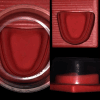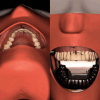A Comparison of Models for Teaching Suturing and Surgical Skills to Dental Students
- PMID: 38803464
- PMCID: PMC11129899
- DOI: 10.1155/2024/3783021
A Comparison of Models for Teaching Suturing and Surgical Skills to Dental Students
Abstract
Learning suturing skills is an important area of the undergraduate curriculum and ideally requires realistic and anatomically accurate surgical training models to prepare students for treating patients. Little is currently understood regarding which model might be perceived by students to be the best or which might most effectively facilitate their learning. The aim of this study was to compare four teaching models: a tabletop silicon dental model, a restricted access tabletop model, a traditional phantom head mounted model, and a Thiel cadaver. Student preferences were explored for each of the models. Following lecture and video-based teaching 67 fourth-year students attended a practical suturing teaching session followed by the second session more focused on the experience of cutting and suturing mucoperiosteal flaps. Forty-six students (67%) gave online anonymous feedback on the first session. The majority (95%) felt prepared to place a simple interrupted suture on a patient, and 88% felt confident to do so. Twenty-eight students (40%) provided feedback on the second session with 82% agreeing that they were prepared to cut a mucoperiosteal flap and 48% felt confident to do this for a patient. The cadaver model was rated as the best of the four models for both suturing and mucoperiosteal flap skills. These results support its use for teaching students to suturing and surgical skills. However, despite this teaching student-rated confidence to cut and suture flaps for a patient remains poor.
Copyright © 2024 Michaelina Macluskey et al.
Conflict of interest statement
The authors declare that there are no conflicts of interest regarding the publication of this article.
Figures



Similar articles
-
An Educational Evaluation of Thiel Cadavers as a Model for Teaching Suturing Skills to Dental Students during the COVID-19 Pandemic.Dent J (Basel). 2022 Jul 4;10(7):125. doi: 10.3390/dj10070125. Dent J (Basel). 2022. PMID: 35877399 Free PMC article.
-
Peer-assisted teaching of basic surgical skills.Med Educ Online. 2015 Jun 3;20:27579. doi: 10.3402/meo.v20.27579. eCollection 2015. Med Educ Online. 2015. PMID: 26044400 Free PMC article.
-
Introduction of Suturing Skills Acquisition into Undergraduate Surgical Education: Early Experience from Ile-Ife, Nigeria.Niger J Surg. 2019 Jul-Dec;25(2):188-191. doi: 10.4103/njs.NJS_5_19. Niger J Surg. 2019. PMID: 31579375 Free PMC article.
-
Perceptions of medical students towards and effectiveness of online surgical curriculum: a systematic review.BMC Med Educ. 2021 Nov 11;21(1):571. doi: 10.1186/s12909-021-03014-x. BMC Med Educ. 2021. PMID: 34763706 Free PMC article.
-
MEDICOL: online learning in medicine and dentistry.Acad Med. 2002 Sep;77(9):926-7. doi: 10.1097/00001888-200209000-00028. Acad Med. 2002. PMID: 12228095 Review.
Cited by
-
Perceptions of the use of a 3D-printed manufactured educational simulator for incisions and sutures.BMC Med Educ. 2025 Aug 19;25(1):1177. doi: 10.1186/s12909-025-07779-3. BMC Med Educ. 2025. PMID: 40830951 Free PMC article.
References
LinkOut - more resources
Full Text Sources

